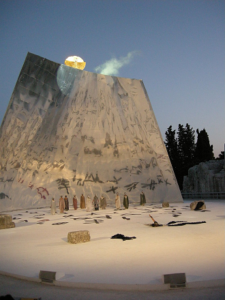
The historical analysis of theopoetry
No one will be converted by reading Sloterdijk, he calls the term religion “nefarious”, but the term not the culture he seeks to delve into, about the term he states: “… especially since Tertullian reversed, in his Apologeticum (197), the expressions “superstition (superstitio)” and “religion (religio)” against Roman linguistic usage: he called the traditional religion of the Romans superstition, while Christianity should be called “the true religion of the true god”. In this way, he produced the model for the Augustinian treatise De vera religione [On true religion] (390), which marked an epoch, through which Christianity definitively appropriated the Roman concept” (pg. 20) and its reasoning and historical vision is much more accurate than the one that wants to appear as if Constantine created a “religion”.
he calls the term religion “nefarious”, but the term not the culture he seeks to delve into, about the term he states: “… especially since Tertullian reversed, in his Apologeticum (197), the expressions “superstition (superstitio)” and “religion (religio)” against Roman linguistic usage: he called the traditional religion of the Romans superstition, while Christianity should be called “the true religion of the true god”. In this way, he produced the model for the Augustinian treatise De vera religione [On true religion] (390), which marked an epoch, through which Christianity definitively appropriated the Roman concept” (pg. 20) and its reasoning and historical vision is much more accurate than the one that wants to appear as if Constantine created a “religion”.
Historical because the influence on Augustine of the Neoplatonists, especially Plotinus, is not only reasonable, but strong enough for what he will write, not in Vera religione, but in his Confessions, which is practically his testament and model of his conversion, Augustine leaves Manichaeism (two opposing poles in dispute) to discover the One (Plotinus’ category), the religion of Love, which earned Hannah Arendt a doctoral thesis.
However, the political action of religion is not denied, Sloterdijk writes, citing Virgil’s Aeneid: “No imperialism rises without the current positions of the constellations in the temporal sky being interpreted, both in the case of those in power and those aspiring to it. Added to them are advice from the underworld: “Tu regere imperio populos, Romane, memento.” (pg. 26 quoting Virgil). In the figure above, Euripides’ representation of Medea from deus ex machina.
He is talking about cultural communities and quotes Constantine: “the symbolic or “religious” and emotional integration of larger units: of ethnicities, cities, empires and supra-ethnic cultural communities — the latter of which could also assume a metapolitical, or rather, anti-political character, as was clear in the case of Christian communities in the pre-Constantinian centuries” (pg. 25-26), when Christians were persecuted and this is history.
The church was already structured at this time: “The bishops (episcopoi: supervisors) were, in essence, something like praefecti (commanders, procurators) in religious attire; its dioceses (in Greek: dioikesis, administration) they resembled the previous imperial districts after the new subdivision made by Diocletius around the year 300; above all through them, the principle of hierarchy reached the ecclesiastical organization in formation…” (pg. 26), thus Constantine in 313 when he places the Catholic religion as the “official” religion [through the influence of his mother Helena] had little or almost no influence its structure.
In fact, in the Jewish heritage, it had already enshrined many rituals: “The mediological principle apò mechanès theós, in fact, deus ex machina, typical of scenic technique or religious dramaturgy, was in fact already in use in several Near Eastern rituals long before to emerge in the Athenian theater” (pg. 28), thus this “deus ex machina” was already present in Judaism.
The author recognizes the religious turn of Jesus: “The god-man, who called himself “Son of Man” inspired by Persian and Jewish sources — possibly a messianic title, but perhaps also just a fazn de parler [way of speaking] to “I” —, came into the world, as he himself was led to say, to sign his teaching with his life” (pg. 32), although he compares him with Socrates and Seneca who had “indispensable convictions”.
Sloterdijk, P. (2024) Fazendo o céu falando; a teopoesia (Making the sky speak: on theopoetry), Trans. Nélio Schneider, Brazil, São Paulo: ed. Estação Liberdade.









